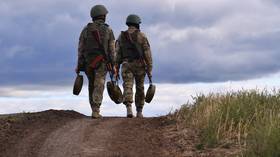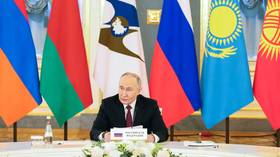Ukrainians complain of ‘morale-zapping’ Russian mines – FT

Ukrainian troops’ inability to breach Russian defensive lines is, to a large extent, due to minefields that are “destroying NATO-supplied armor, wounding soldiers and zapping morale,” according to the Financial Times.
Kiev’s much-lauded counteroffensive, launched last month, has stalled in the face of staunch resistance from Russian troops. Western-made tanks and infantry fighting vehicles have failed to secure the swift territorial gains that many supporters were expecting, and Kiev has since changed its approach, keeping valuable vehicles behind and trying to slowly erode Russian defenses from a distance.
While there are many factors behind the failed push, Russian minefields appear to be the most “daunting” for the Ukrainian troops, the FT reported on Thursday.
“We can push with 10 brigades but it won’t work because the mines are everywhere, every half a meter there are mines,” a Ukrainian unit commander told the British newspaper.
According to the article, Russian military engineers design minefields in ways “to specifically negate” the minesweeping equipment that Ukraine has. Kiev could use more man-portable systems now that soldiers have to move on foot rather than under the protection of armor, Ukrainian leaders said.
Mine injuries – rather than shrapnel wounds from artillery strikes – have become the dominant type of trauma at a frontline field hospital visited by the FT. One doctor said he performs dozens of surgeries daily, most of which are amputations.
Ukraine has become one of the most-mined places in the world, with the UN citing Kiev’s estimate that some 30% of its claimed territory was contaminated by explosive ordinance. Last year, the Kiev, Kharkov, Chernigov, and Sumy regions were heavily mined by Ukrainian forces in anticipation of Russian advances.
In the Donetsk and Lugansk People’s Republics, some of the hazards date back to 2014, when a new government in Kiev deployed its military in an attempt to crush a rebellion. Kiev’s use of remotely deployed anti-personnel “petal mines” has been a constant threat to civilians in those areas.
The need for future demining will likely be exacerbated by the US decision this month to provide cluster artillery rounds to Ukraine. Such weapons scatter smaller bomblets over a large area, some of which fail to trigger and may injure people years later, effectively working as mines. Washington has said Kiev will use the arms responsibly to minimize harm to civilians.













